AMD Launches Mobile Kaveri APUs
by Jarred Walton on June 4, 2014 12:01 AM ESTAMD Kaveri FX-7600P System/CPU Performance Preview
After the briefing, we were given a chance to benchmark a prototype Kaveri notebook for a few hours. That wasn't enough to run our full suite of laptop benchmarks, and battery testing in particular is something we couldn't perform. I did run some quick simulations of battery life; however, the prototype systems are optimized more for performance rather than power, so the results weren't really meaningful. We'll have to wait for retail laptops with Kaveri APUs before we can really see what sort of battery life to expect, but AMD claims there should be a decent jump in mobility compared to Richland.
The test systems were more of a proof of concept rather than anything you could actually sell. The keyboard was okay if a little mushy, but the touchpad in particular I found a bit lacking, and build quality was mediocre as well. The screens at least were good quality 1080p 15.6" touchscreen panels, and that was enough to get us benchmarking. I snapped a few pictures of the laptop that you can see above. In terms of other core specs, the laptop had 8GB of DDR3-1866 RAM and a Samsung M.2 256GB SSD.
For our purposes here, we're including the AMD Kaveri Prototype, AMD Trinity Prototype, and AMD Kabini Prototype laptops as a starting point. For retail laptops, we have the MSI GX60 with Richland A10-5750M APU (but only a single 8GB SO-DIMM, unfortunately), the Sony VAIO Pro 13 (i5-4200U), and the Acer V7-482PG (i7-4500U + GT 750M). The Acer is the only laptop equipped with a discrete GPU, so we wanted to see how Kaveri stacks up against such a system. You can compare additional results against Kaveri in Mobile Bench, of course.
Again, these numbers are only preliminary – the drivers for the GPU were slightly older (without Mantle support enabled yet), and there were occasions of odd behavior where other editors had scores that didn't match up with our results until after a reboot. We were not able to run each benchmark multiple times, so most of these results are from a single run. AMD is keen to talk about the GPU improvements with Kaveri, but I also wanted to see what has happened on the CPU side, so we'll start with our CPU/system benchmarks.
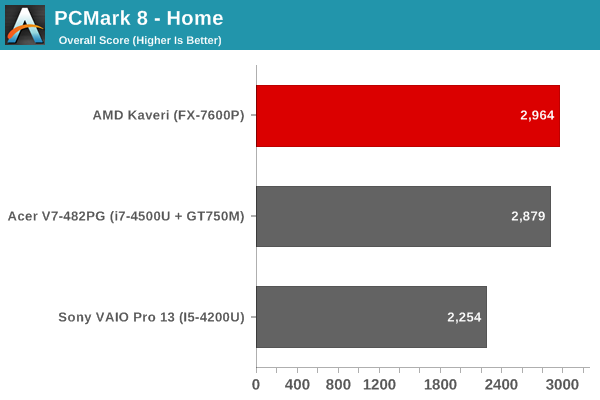
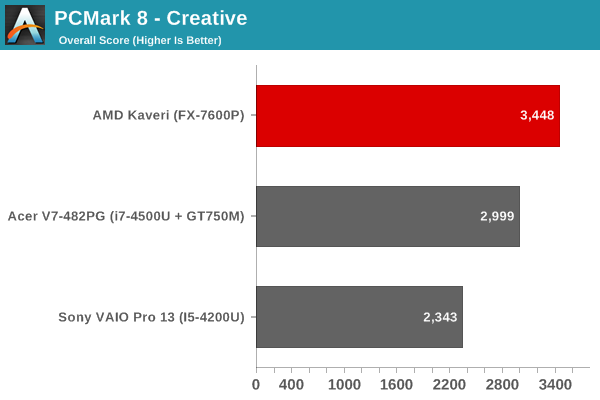

We don't have results for PCMark 8 for many of the systems, and the VAIO Pro 13 seems to be underperforming for some reason, but otherwise we get a pretty good idea of where things fall in terms of overall performance. Note that PCMark 8 is now OpenCL accelerated, which can improve performance quite a bit on AMD APUs. The result is that AMD actually takes the lead in the Home and Creative suites, but without more time benchmarking the system I wouldn't try to draw too many conclusions. Storage subsystem performance can still have an enormous impact on PCMark results, and the V7-482PG has to get by with an SSD caching solution. The VAIO Pro 13 on the other hand just seems to score a bit lower than I'd expect, so again take these scores with a grain of salt.
Moving on to other benchmarks, I also ran PCMark 7 as it doesn't have any OpenCL acceleration and will provide a better view of traditional application performance. Hopefully we'll continue to see improvements in the use of OpenCL (GPU) acceleration and over time PCMark 8 scores will be more indicative of real-world performance, but right now there are plenty of situations where having a GPU does very little for performance.

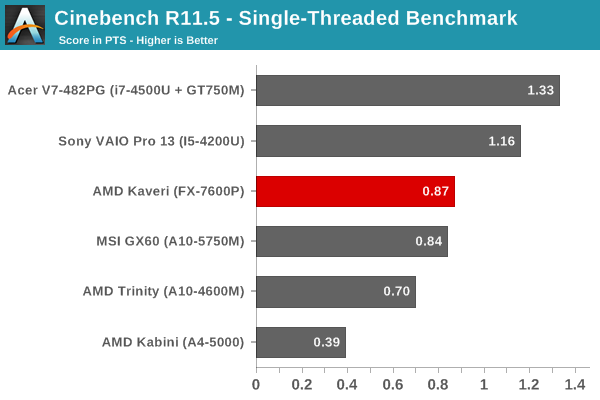
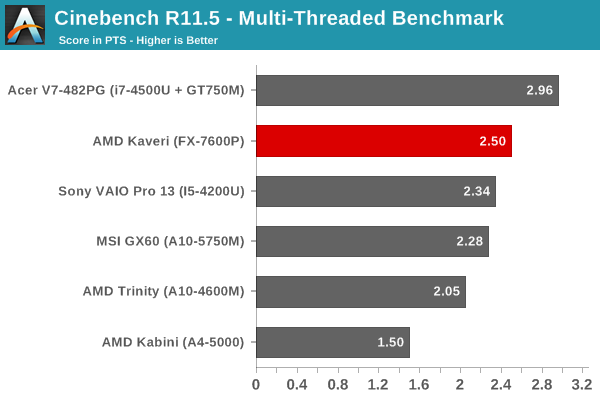
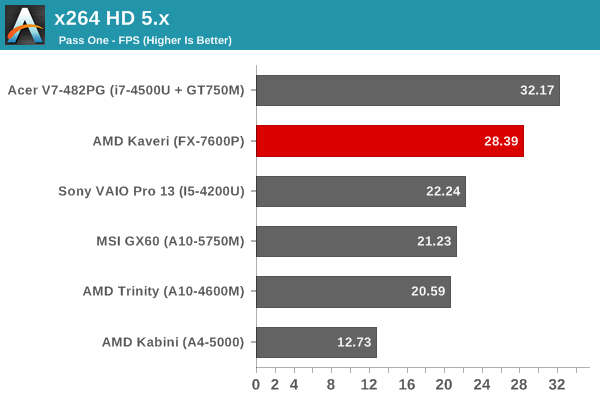
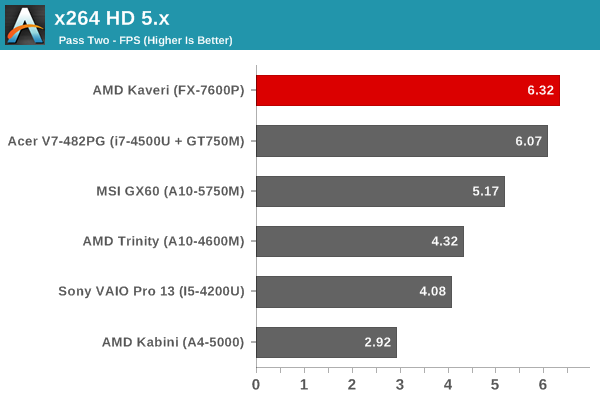
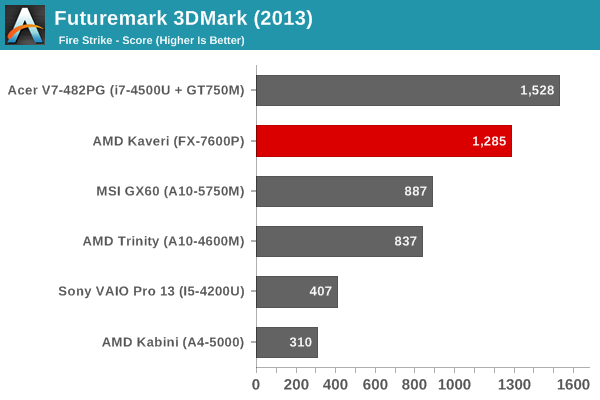
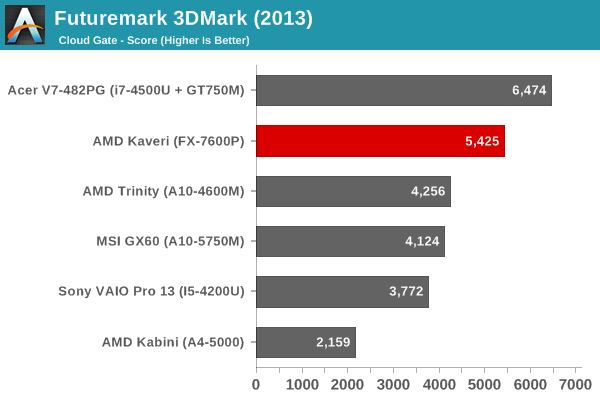

Somewhat surprisingly, Kaveri actually takes the lead in the very demanding second pass of the x264 HD 5.0 encoding test. Granted, we're looking at a 35W APU vs. 15W ULV CPU, and Intel's 37W quad-core parts would certainly retake the lead (and cost quite a bit more), but at least Kaveri is showing some real improvements over Richland in these tests. As noted above, PCMark 7 doesn't have any OpenCL optimizations so the gap between AMD and Intel is a bit wider.
Moving to the 3DMark results, Kaveri shows an impressive increase in performance over the Trinity/Richland GPU, which is expected. Intel's iGPU – particularly in the ULV system shown here – just doesn't stand a chance. While we are potentially TDP limited for the ULV Intel parts in graphics tests, my experience is that 3DMark hits the GPU much more than the CPU, so the GPU gets the lion's share of the TDP. I'll try to run some tests on other Haswell systems using the iGPU to verify the above results, but outside of the HD 5000 and Iris parts, I wouldn't expect Intel's iGPU to be too much faster than what we're seeing here.
Overall, an Intel CPU with a discrete GPU is still faster than Kaveri in most areas, and a quad-core i7-4702QM would really distance itself from AMD's Kaveri…but the quad-core i7 CPUs tend to start at around $350, so there's not much point in discussing that comparison. My personal feeling is that unless you're really pushing a laptop hard, most of the modern CPUs/APUs are plenty fast. I wouldn't want a Kabini APU, but Trinity/Richland, Ivy Bridge, Kaveri, and Haswell are all going to be fine for everyday use.
The more important element for me with a laptop (or desktop) is that I simply can't stand using conventional hard drives for the primary storage device any longer. Given the choice between an AMD Kaveri APU with a 256GB SSD (the Crucial MX100 is sure looking nice!) and pretty much any other laptop that has pure HDD storage, it's a no brainer for me. In fact, laptop manufacturers would do their customers a great service if they took the cost savings of AMD's APU vs. Intel's CPU and put that into a decent SSD solution rather than chasing the lowest possible price!


_thumb.jpg)
_thumb.jpg)
_thumb.jpg)
_thumb.jpg)
_thumb.jpg)








125 Comments
View All Comments
MLSCrow - Wednesday, June 4, 2014 - link
Who cares that it's slower as a CPU? Beside the point that it's not even noticeably slower, have you forgotten that it's not a CPU at all, but rather an APU, and as an APU its performance is something to be praised not degraded. Intel fans have honestly become the worst fanboys out there now. Can't give credit where it's due and can only make negative comments, even in the light of positive results. Facepalm.kingpin888 - Thursday, June 5, 2014 - link
Dude, mobile AMD Kaveri has a 35W TDP and is quad core and intel i5 is dual core and has a 35W and 47W TDP. What are you talking about ??Gondalf - Wednesday, June 4, 2014 - link
Jarred.....Anand.....you are comparing an hot 35W SKU with a constrained 15W ultrabooks SKU.This time there is no justification, Anantech lab is plenty of notebooks with a 37W Intel cpu on board and i pretty believe of notebooks with 28W U parts with a less constrained HD 5000 or Iris 5100 GPUs. And why a i7 4500 (GT2) and not a i7 4550 (GT3) ??????
This is a pretty biased article, nearly useless for customers.
JarredWalton - Wednesday, June 4, 2014 - link
Comparing $300 CPUs against $150 APUs is potentially just as bad. And you'd be surprised how many laptops we don't actually have; most come with high-end configurations, which really muddies the waters. I do have a 37W i7-4702MQ available where I can disable the dGPU and see how performance compares, but that's a $370 CPU and again just not anywhere near the price of the AMD offerings. (Base price on the laptop is $1500+.)Morawka - Wednesday, June 4, 2014 - link
your looking at tray cost. overall laptop costs will be comparable, intel has much more components on die. maybe $150 off. I would have liked to see a comparable wattage intel cpu in there as well.Gondalf - Thursday, June 5, 2014 - link
Yes agreed with you.The perfect review could be with a i7 4550 or i5 4250 both GT3 with TDPup enabled up to 21/22 W. We have forgotten that Kaveri is 19W but we need of other 2/3W for southbridge that is on package on Haswell.
Looking at others reviews, in this conditions Intel and Amd are average on pair in GPU (depending on game title) and Intel is in huge advantage in CPU. The 19W (21/22) TDP figure seems an attempt to put sand in customer eyes.
Lets wait a review with real Notebooks, yes because the TDPup feature is largely utilized by Intel OEMs to have more performance from mobile Haswell.
Thermogenic - Wednesday, June 4, 2014 - link
Can't wait until we get real laptops tests - tests without battery life on a mobile device aren't all that useful anymore.JarredWalton - Wednesday, June 4, 2014 - link
Yeah, I tried to check it and found that the prototype was basically not tuned at all for battery life -- probably would have been under four hours for Internet surfing, which is way out of line with what we expect. Basically, idle power draw was around 16-17W, almost double what it should be, so the firmware and hardware wasn't tuned to go into low power states as far as I could tell. When we get shipping laptops, I suspect we'll see battery life competitive with Intel solutions, maybe even better. I figure 5-6W idle power draw or less isn't too far off these days.s44 - Wednesday, June 4, 2014 - link
Competitive with Haswell or with Ivy Bridge? Battery life really is everything for most laptop use.JarredWalton - Wednesday, June 4, 2014 - link
Haswell is obviously the target, and AMD is claiming 11 hours vs. 9.2 hours for Kaveri vs. Richland (doing a low intensity eReader/Browser test), so that's at least a decent bump. But I've seen Trinity laptops with lousy battery life due to the OEM not spending the needed effort in that area, so really it's as much the laptop as it is the CPU/APU.